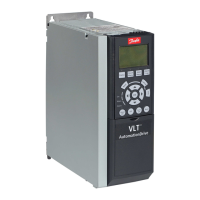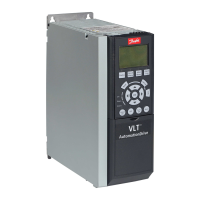FC 300 Design Guide
Introduction to FC 300
The following parameters are relevant for Process Control
Parameter Description of function
Process CL Feedback 1 Resource Par.
7-20
Select from which resource (i.e. analog or pulse input) the Process PID
should get its feedback
Process CL Feedback 2 Resource Par.
7-22
Optional: Determ i ne if (and from where) the Process PID should get an
additional feedback signal. If an additional feedback source is selected,
the two feedback signals w ill be added together before being used in the
Process PID Control.
Process PID Normal/inverse Control
Par. 7-30
Under [ 0] Normal operation, the process control will r espond with an
increase of the motor speed if the feed back is getting lower than the
reference. In the same situation, but under [1] Inverse operation, the
process control will respond with a decreasing motor speed instead.
Process PID Anti Windup Par. 7-31 The anti-windup function ensures that when either a frequency limit or a
torque limit is reached, the integrator will be set to a gain that corresponds
to the actual frequency. This avoids integrating on an error that cannot in
any case be compensated for by mea ns of a s peed change. This function
can be disabled by s electing [0] "Off".
Process PID Controller Start Value
Par. 7-32
In some applications, reaching the required speed/set point can take a very
long time. In such applications it might be an advantage to set a fixed motor
speed from the frequency converter before the proc es s control is activated.
This is done by setting a Process PID Start Value (speed) in par. 7-32.
Process PID Proportional Gain Par.
7-33
Thehigherthevalue,thequickerthecontrol. However,toolargeavalue
may lead to oscillations.
Process PID Inte gral Time Par. 7-34 Eliminates steady state speed error. Lower value means qu ick reaction.
However, too small a value m ay lead to oscillations.
Process PID Differentiation Time Par.
7-35
Provides a gain proportional to the rate of chan ge of the feedback. A setting
of zero disables the differentiator.
Process PID Differentia tor Ga in Limit
Par. 7-36
If there are quick changes in reference or feedback in a given application -
which means that the error changes swiftly - the differentiator may soon
become too dominant. This is because it reacts to changes in the error.
The quicker the e rror changes, the stronger the differentiator ga in is. The
differentiator gain can thus be limited to allow setting of the reasonab le
differentiation time for slow changes.
Process PID Feed Forward Factor Par.
7-38
In applications where there is a good (and approximately linear) correlation
between the process reference and the mot o r spe ed necessary for obtaining
that reference, the Feed Forward Factor can be used to achieve better
dynamic performance of the Process PID Control.
Par. 5-54 (Pulse Filter Time Constant
#29), Par. 5-59 (Pulse Filter Time
Constant #33), Par. 6-16 (Terminal
53 Filter Time Constant), Par. 6-26
(Termina l 54 Filter Tim e Constant)
If there are oscillations of the current/voltage feedback signal, these can be
dampened by means of a low-pass filter. This time constant represents the
speed limit of the ripples occurring on the feedback signal.
Example: If the low-pass filter has been set to 0.1s, the lim it speed will
be 10 RAD/sec. (the re ciprocal of 0.1 s ), corre sponding to (10/(2 x π)) =
1.6 Hz. This means that all currents/voltages that vary by more than 1.6
oscillations per second will be d amped by the filter. The control will only
be carried out on a feedback signal that varies by a frequency (speed) of
less than 1.6 Hz.
The low-pass filter improves steady state performance but selecting a too
large filter time will deteriorate the dyna mic perform ance of the Process
PID Control.
36
MG.33.B6.22 - VLT is a registered Danfoss trademark

